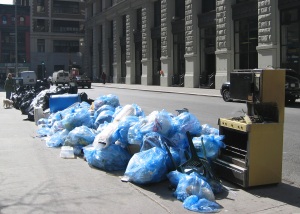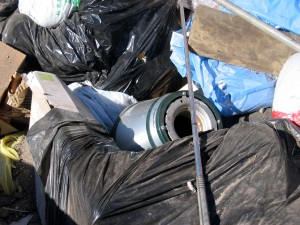When you lift the lid off your trash can on a warm summer day, you won’t be much inclined to think of garbage as a relative value. Some things have a fleeting, indefinable essence that shifts with the context. Not garbage. There’s nothing “je ne sais quoi” about putrescence.
I wouldn’t be surprised if it turned out that our aversion to garbage is hardwired—a biological absolute. Your chances of survival probably improve if you can’t bring yourself to eat food that’s gone off. Given such a strong proclivity against the overripe, it came as a surprise to me to discover that as late as the 1950s a Dutch farmer could explain to his village government that he didn’t participate in the garbage collection program because he didn’t have any garbage to give away. He lists out the leftovers:
- Newspapers go to the Christian mission.
- Empty tins are donated to Stegeman, the ragman.
- Dirty paper and floor sweepings end up in the stove.
- Wood and coal ash from the hearth help to firm up the edges of his own farmyard.
That’s it. The list is vaguely reminiscent of our own recyclables sorting litanies, but there’s one stunning difference: once farmer den Boer was done recycling, he had nothing left over. In any event, nothing worth giving to the trash man, he says. What he did with his actual garbage—the putrescibles, that is—we have no way of knowing because he doesn’t include it on the list. To him, I conclude, it wasn’t garbage at all, but pig slop or perhaps fertilizer, to be chucked on the dung heap and plowed under in the springtime.
In other words, garbage is contextual. The anthropologist Mary Douglas famously said that dirt is “matter out of place.” Just so, garbage is food scraps out of place, organics withdrawn from the cycle of life. Which is why it started out as an urban concept.

Garbage in New York
Cities are places where leftovers cannot be put to use where they are produced. It took a long time for cities to develop effective waste removal systems, and while leftovers lingered on city streets they transmogrified from fertilizer into filth. An embarrassment in context, a source of disease, an impediment to traffic. Garbage. Once swept up and carried outside the city gates, the garbage transformed right back into its constituent character as agricultural nutrient and farmers stood waiting to scoop it up, paying money for the privilege.
Another transformation took place in the 2oth century, when garbage morphed from an urban concept into a petroleum-based concept. Garbage is no longer fertilizer if you can derive it more cheaply from petroleum. In this country, garbage became just irredeemably garbage. We started sweeping it under the rug, storing it up for the future, hiding it in places euphemistically known as landfill.
Even if garbage is not economically repurposable as fertilizer, it can still be turned into energy—by incineration (which creates more leftovers useful for road building) or by methane recovery (which leaves some temporarily useless dross in place). Just how economical that is still depends on the price of oil. It was quite remarkable how many permits for landfill- gas-to-energy plants were issues when gasoline sold for more than $4.00 a gallon at the pump. There are almost 500 of those landfills in the U.S. already.
What’s more, it’s useful to start thinking of landfill as landmine. The closer we get to the bottom of the natural resource barrel, the more attractive it is going to be to dig all the trash back up and recycle it after all. If the need arises, and most likely it will in the not-too-distant future, trash will transmogrify to ore. In other words, what is true for putrescibles, is also true for durable goods—even if “durable” is a misnomer in times of built-in obsolescence and compulsive consumption.

Durable trash
In times of economic expansion, many of the durable components of our trash are valuable, especially metals. Just last year, there was such a market for scrap metal that scrappy entrepreneurs were declining to wait with their scavenging activities until someone officially discarded their stuff. Manhole covers kept disappearing from the streets. Telephone wires were dismantled. I heard about people pulling up stretches of tram- and rail-line to convert the materials to ready cash at the scrapyard.California even made some legislation to penalize scrap dealers for accepting metals that were obviously stolen (such as those manhole covers and other infrastructure belonging to the people). A month or so later, the economy took a decisive turn south, prices for raw materials fell as demand declined, inventory started piling up, and so did the recyclables in the storage yards of the collectors. The New York Times even recommended that we, concerned consumers, better hang on to those recyclables for a bit if we didn’t want to see them end up in the dump.
I’ve never been much inclined to think we’re in the midst of a rational economic system—and I daresay it’s easier to find people to agree with me in recent times—but it is a significant consolation to realize that garbage is not a terminal condition. To all of you out there who occasionally write to me in despair: yes, it’s embarrassing that we’re creating so much garbage, and, no, it’s not easy to live in the midst of endless wealth and not create so much trash. But garbage is reversible. And though we may not be thoroughly rational creatures, the times are offering a little more incentive going forward to not be quite as dumb as we have been.